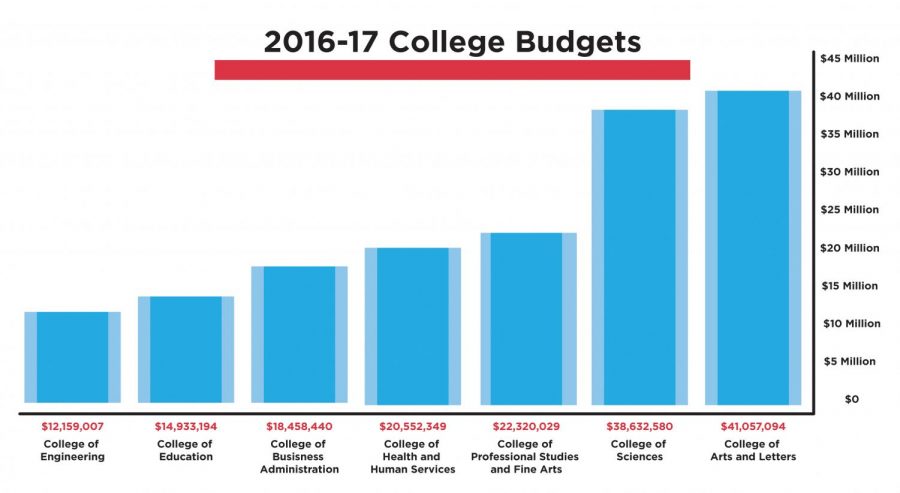San Diego State had a budget of nearly $400 million during the 2016-17 school year.
Where did all of that money go?
Out of the university’s budget of $387,002,408 during the last school year, the most costly subsection is academic affairs, calling for $133,203,902 in funding according to SDSU’s budget book.
Academic affairs is responsible for all instructional activity, the library, enrollment services, instructional technology, graduate/research programs and extended studies programs at SDSU in both San Diego and the Imperial Valley. The most significant piece of this is instructional activity, which includes all the individual colleges within the university and their separate funding budgets.
The College of Arts and Letters has the highest funding, at more than $41 million, as well as the most academic programs with 37. However, its enrollment falls short of many other colleges — it had just 4,206 students in fall 2017, compared to 6,032 in the College of Business Administration.
Enrollment and number of programs, although significant, aren’t the only determinants in which college gets the most funding.
More important than the number of students enrolled in the college itself is the number of full-time equivalent students enrolled in a college’s courses overall, Radmila Prislin, associate vice president of Academic Affairs, said. This number could be larger than the college’s enrollment in its major programs due to general education or explorations requirements.
While the College of Business Administration has the highest enrollment, its budget approaches $18 million. Most of the colleges’ annual budgets sit between $15 million and $23 million, with the College of Arts and Letters and the College of Sciences being major exceptions.
The College of Sciences had a funding budget of more than $38 million for the 2016-2017 school year, servicing 5,824 students as well as 24 major programs, according to the budget book and SDSU analytic studies and institutional research. Their high budget is primarily due to costs in their operating budget, which is the part of the budget that looks at supplies, services and equipment.
“The College of Science has lots of labs that require lots of equipment,” Prislin said. “Therefore, they have substantial funding in the operating department of the budget.”
On the lower end, the College of Engineering operates on the smallest budget of the group at $12,159,007. This college has 12 major programs and an enrollment of 4,270 students.
The College of Health and Human Services has a funding budget of $20,552,349. This college contains 17 academic programs while enrolling 4,933 students, according to SDSU’s Office of Analytic Studies and Institutional Research website. This is followed by the College of Professional Studies and Fine Arts, with a budget of $22,320,029 as well as 29 different programs and an enrollment of 4,754.
Lastly is the College of Education, with the second smallest budget sitting at $14,933,194. This college has the lowest enrollment at 1,839 students split between 13 programs.
The budget is decided on incrementally, meaning it is adjusted upward or downward on a yearly basis dependent on each college’s needs, Prislin said. For example, if a college needs to hire more professors, their budget may be increased to account for new staff salaries.
“We start with what we have at the end of one fiscal year and we either augment it or sometimes reduce it by whatever variable factor we have to address,” Prislin said.
The specifics of the budget are discussed both at the system and local levels in different capacities, dependent on what aspect of the budget is at hand.
Since SDSU is unionized, salaries and salary raises within colleges are negotiated by union representatives at the system level through a system of collective bargaining, Prislin said. Collective bargaining describes the negotiation of wages by an organized body of employees, in this case the union representatives.
Decisions made regarding the budget at the local level occur through a process of shared governance. When decisions have to be made about investing in certain critical needs, requests for the funding are taken to the Presidential Budget Advising Committee (PBAC), which consists of faculty representatives, a student representative and a senate representative.
“These (requests) are discussed in the context of our strategic plan and the critical needs,” Prislin said. “Of course, they are responded to within the constraints of the available money.”
While the university receives funding from a variety of sources, the primary source is the university’s general fund. This consists of an allocation for funding from the state, student tuition and revenue generated from the student success fee.












